Community Capacity Building Program PowerPoint PPT Presentation
1 / 34
Title: Community Capacity Building Program
1
Community Capacity Building Program
- Interpersonal Communications
2
Agenda
- Icebreaker
- Welcome and Overview
- Communication Process
- Types of Communication
- Verbal
- Non-verbal
- Listening
- Factors Influencing Communication
- Parking Lot
- Discussion/Evaluation
3
Interpersonal Communications Skills Exercise 1
- Pair participants with someone they dont know,
if possible - Take five minutes to interview each other to
learn enough to introduce your partner to the
group - Each person introduces their partner to the group
4
Interpersonal Communication Skills
- What is communication?
- A process in which a person, through
language,signs and symbols, conveys a message to
another person - Comprised of
- Sender
- Message
- Channel
- Receiver
- Feedback
- Barriers
5
Interpersonal Communication Skills
- Sender
- Language and how you use it
- Credibility
- Knowledge of content, audience and context
- Experience, attitudes and values
- Message
- Written words, sentences, paragraphs
- Oral use of voice tone and pitch
- Non-verbal gestures, facial expressions, eye
contact, environment (office set up)
6
Interpersonal Communication Skills
- Channel
- Verbal face to face meetings, telephone, video
- Written reports, letters
- Receiver
- Abilities
- Attitudes
- Experience
- Feedback
- Receiver responds in some way
- Sender can evaluate effectiveness of message
7
Interpersonal Communication Skills
- Barriers
- Inappropriate medium or channel
- Incorrect grammar, inflammatory words, words that
conflict with body language - Technical jargon
- Noise
- Can occur at any stage
- Can be interference from various sources radio,
chatter, etc.
8
Interpersonal Communication Skills - Exercise 2
- Discuss barriers to communication process
- Brainstorm and discuss some barriers in your
workplace or volunteer group
9
Interpersonal Communication Skills - Exercise 3
- Identify strategies to deal with common
communication problems
10
Types of Communication
- Verbal
- Non-verbal
- Listening
11
Types of Communication - Exercise 4
- How we communicate
- Role Play
12
How we communicate
- Verbal 7
- Quality and tone of voice 38
- Visual (non-verbal) 55
13
Verbal Communication
- Speech
- Range
- Pitch
- Volume
- Enunciation
- Pronunciation
- Infliction
- Tone
14
Non-verbal communication
- Body language
- Written communication
15
Non-verbal communication
- Appearance/Image
- Environment
16
Interpreting Non-verbal Behaviour Exercise 5
- Discover what you know about non-verbal language
- Think about some non-verbal behaviours that have
not been discussed
17
Listening - Exercise 6
- Complete the listening skills exercise
- Rate your listening skills
18
Types of Listening
- Pseudo
- Listen to meet some other need
- Make people think you are interested
- Keep alert to see if you are being rejected
- Get some time before your next comment
- Pretend to be listening to be polite
- Natural to be pseudo listening some times
19
Types of Listening
- Active
- Listen without barriers (time, emotional)
- Listen to the entire message by focusing on
verbal and non-verbal message - Listen using your non-verbal communication skills
- Listen to the person without interrupting,
judging or arguing - Clarify and ask questions or paraphrase
20
Improving Listening through Feedback
- Paraphrasing
- Perception checking
- Describing behaviour
- Making I statements
21
Paraphrasing
- Tests your understanding of communicators
message - Allows communicator to clarify a misunderstanding
- Provides climate where communicator can feel
understood - Provides communicator with sense that what they
are saying is important
22
Perception Checking
- Describe other's feelings or behavior
- Indicates to person that you want to understand
their feelings - State interpretation of behavior
- Ask if interpretations are accurate
23
Describing Behaviour
- State what has been observed
- Does not judge behaviour
- Use it to indicate negative behaviour
- Provides non-threatening opening to further
communication
24
Making I Statements
- Use when you want to explain your feelings
- Use to reduce level of tension in conflict
situation
25
Making I Statements
- How to make an I statement
- When (description of behaviour, not person),
- I feel (description of the feeling,
- Because (tangible or real effect) or how about if
(suggestion for change) pushes speaker to define
what disturbs him/her
26
Paraphrasing - Exercise 7
- Discuss some ways to provide feedback through
paraphrasing - Discuss the exercises in manual
27
Giving and Receiving FeedbackExercise 8
- Assign groups
- Write your responses
- Share responses with group
- Select one response to share with large group
28
Ways We CommunicatePublic Speaking - Exercise 9
- Discuss public speaking fears
- Discuss some strategies to improve public
speaking fears
29
Ways We Communicate
- Speeches
- Presentations
- Correspondence/office communication
- Telephone
- Voice mail
- Websites
- Blogs
- Others?
30
Email Practices - Exercise 10
- Discuss advantages and disadvantages of email
31
Factors Influencing Effective Communication
- Special needs/accessibility
- Environment/setting
- Literacy skills
- Cultural factors
- Email etiquette
- Tone
- Respect and appropriateness
- Gender neutrality
- Jargon
- Others
32
Communication Blockers
- Responses that can block effective communication
- Evaluation response
- Advise giving response
- Topping response
- Diagnosing, psychoanalytic response
- Prying-questioning response
33
STRATEGY PLANNING RELATIONSHIP BUILDING ORGANIZATIONAL SKILLS MANAGEMENT CO-OPERATIVE DEVELOPMENT
Strategic Planning Community Development Organizational Governance Basics of a Co-operative
Proposal Writing Public Participation Board Orientation Co-operatives and the Community Development Process I
Project Management Alternative Dispute Resolution Meeting Management Co-operative and the Community Development Process II
Opportunity Identification Group Dynamics Leadership and Motivation
Opportunity Management Interpersonal Communications
Communications Planning
Legal Issues
34
Conclusion and Evaluation
- Review objectives
- Review any additional expectations
- Review Parking Lot
- Point out Certificates of Participation
- Complete evaluation
- Thank you!
Community Capacity Building Program
www.intrd.gov.nl.ca/intrd/regionaldev/capacitybui
lding.html

